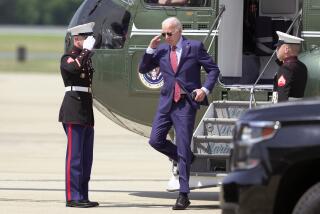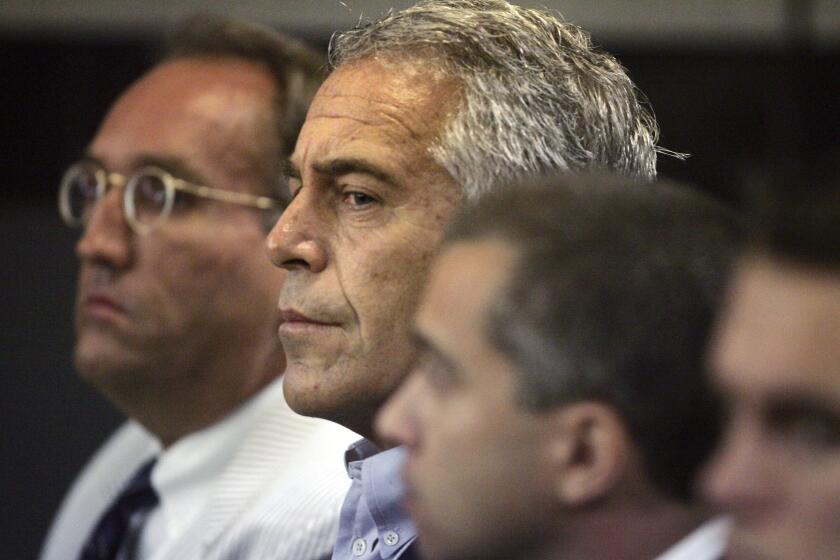Allies to Ban All Planes, Copters in Shiite Zone : Persian Gulf: Bush announcement is expected today. No shield is planned against Iraqi ground attacks.
- Share via
WASHINGTON — President Bush will announce today that the United States and its allies will immediately begin enforcing a ban on flights by all Iraqi helicopter and fixed-wing aircraft in the nation’s Shiite Muslim-dominated south but will stop short of offering broader protection, Administration officials said Tuesday.
The U.S.-led military operation will protect Iraq’s 12 million Shiites from air attack but will not shield them from ground assaults or other forms of repression by the regime of Saddam Hussein, who has been waging a growing offensive against Shiite civilians and insurgents in the southern marshlands.
Bush will portray the allied action as consistent with U.N. resolutions that warn Baghdad against repression of its citizens and empower the victorious Persian Gulf War allies to enforce the cease-fire terms.
The United States and its allies will warn Hussein against using ground troops against Shiite civilians and rebels but are not prepared to attack them from the air or commit ground forces to stop the attacks, officials said Tuesday.
“We’re not ruling out the possibility” of escalating allied action against Iraq, a senior Administration official said. “But there has been no decision to use ground forces.”
According to the officials, Bush will say that the United States and its allies are acting now because of the increasing ferocity of Iraqi repression of the Shiites. The announcement will mark the conclusion of a long debate within the Administration and between the United States and its allies about how best to respond and how to increase pressure on Baghdad.
Anticipating charges that he is manufacturing a foreign crisis to enhance his reelection prospects, Bush said last Thursday in his acceptance speech at the Republican National Convention that he would never allow politics to dictate the use of American military forces overseas.
Under the ban, the United States, Britain and France will institute a round-the-clock combat air patrol in the skies over roughly the third of Iraq that lies south of the 32nd Parallel, officials said. The planes will fly from airfields in Saudi Arabia, Kuwait, Oman and other Gulf states, as well as from the aircraft carrier Independence, now sailing in the northern Persian Gulf.
Another senior Administration official said that the most important target of the ban would be machine-gun attacks by Iraqi helicopter gunships on Shiite villages in the marshy region along the Iran-Iraq border.
Iraqi warplanes that defy the so-called “no-fly” zone in southern Iraq probably will be shot down on sight without warning, a U.S. admiral said in the Gulf on Tuesday.
“I would guess that if the scenario plays out the way it is envisaged now, they would be given an adequate warning by diplomatic notice not to fly in that particular area,” Rear Adm. Brent Bennitt told reporters aboard the Independence.
“To me that would be sufficient warning. . . . I wouldn’t anticipate any warning shots,” the admiral said.
British and French officials announced their support for the plan last week. British Prime Minister John Major said it appeared that President Hussein was pursuing a genocidal policy in the marshes.
With Iraq conducting military operations in the region from both the air and ground, some officials argued that the imposition of the no-fly zone would not be enough to halt the regime’s repression.
But the second senior official said that a review conducted at the highest levels of the Administration in recent weeks has concluded that Iraq’s Soviet-made Hind helicopter gunships were “the main instrument of destruction” in the region.
Virtually all of the 30 fixed-wing Iraqi aircraft that had been operating in the south were withdrawn north of the 32nd Parallel over the weekend, Pentagon officials said. In addition, many of the 40 helicopters spotted in the area in recent weeks also appear to have been withdrawn, the officials said.
According to U.S. intelligence estimates, Baghdad has deployed between 80,000 and 100,000 ground troops in the southern third of the country. The troops are a mix of regular army, elite Republican Guards and internal security forces, sources said.
Pentagon spokesman Bob Hall said the Iraqi military is conducting operations against the Shiites in units of battalion size (about 800 men) or smaller. “But they also maintain deployments that are large enough and structured in a way that they would be sufficient to launch large-scale operations on very short notice,” Hall said at a briefing Tuesday.
The United States has more than 100 ground-based aircraft within striking range of Iraq, as well as the full complement of 72 attack, interdiction and surveillance craft aboard the Independence. More than 25,000 U.S. military personnel are currently in the region, including 2,400 Army troops in Kuwait for an exercise dubbed “Intrinsic Action.”
Britain and France have sent much smaller air wings to the region to participate in the operation.
In London on Tuesday, Russian Foreign Minister Andrei V. Kozyrev endorsed creation of a no-fly zone and the use of military force to protect residents of southern Iraq.
Emerging from a meeting with Acting Secretary of State Lawrence S. Eagleburger, Kozyrev said that force should be used if necessary to compel Iraq to comply with U.N. resolutions.
Broder reported from Washington and Jehl from Chicago. Times staff writers Norman Kempster in London and Robin Wright in Washington contributed to this story.
More to Read
Sign up for Essential California
The most important California stories and recommendations in your inbox every morning.
You may occasionally receive promotional content from the Los Angeles Times.













